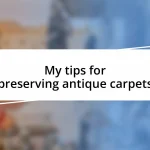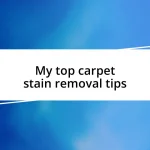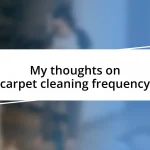Key takeaways:
- Understanding the different types of carpet brushes (stiff, soft, grooming, nylon, and natural fiber) is essential for effective cleaning and maintaining carpet longevity.
- Proper preparation before brushing, including vacuuming and removing obstacles, enhances cleaning efficiency and prevents damage to the carpet and brush.
- Regular maintenance of the carpet brush, including cleaning and checking for wear, is crucial to ensure effective performance and extend the brush’s lifespan.

Understanding Carpet Brush Types
When it comes to carpet brushes, understanding the different types can significantly affect your cleaning experience. I remember when I first encountered a stiff-bristle brush; I was amazed at how effectively it lifted ground-in dirt and debris from my high-traffic areas. It’s just one of those moments where you realize that the right tool can make all the difference, don’t you think?
There are primarily two categories of carpet brushes: those with stiff bristles and those with softer ones. Personally, I prefer using soft-bristled brushes for delicate carpets because they prevent damage while still removing dust and pet hair. It’s fascinating how a simple choice can impact the longevity of your carpet—have you ever experienced the regret of using the wrong brush and ruining a favorite piece?
Another type worth noting is the grooming brush, which is perfect for maintaining the appearance of your carpet. I recall a time when my plush carpet was looking a bit flat and lifeless. After using a grooming brush, it felt rejuvenated and fluffy again. Isn’t it rewarding to see your carpet transform with just a bit of effort and the right brush? Understanding these types ultimately leads to better care and a more vibrant living space.

Choosing the Right Carpet Brush
Choosing the right carpet brush is essential to maintaining the beauty and longevity of your carpets. I remember walking through a friend’s home and admiring her vibrant, well-maintained carpets. She shared that the secret to their upkeep was choosing brushes that suited her specific carpet types. It made me realize that understanding your carpet’s material is just as crucial as the brushing technique itself.
Next, consider the size and weight of the brush. When I first started cleaning my carpets, I opted for a bulky brush thinking it would boost efficiency. However, I quickly found that it was cumbersome and tiring to use. Switching to a lightweight, ergonomically designed brush made the task feel less like a chore and more like a quick refresh. Sometimes, small changes can have a significant impact on your cleaning routine!
Lastly, think about the bristle material. Nylon, for instance, is fantastic for durability and can tackle tough stains, while natural fibers can be more gentle on delicate fabrics. My experience has shown me that combining a stiff-bristled brush with a grooming brush for final touches creates a robust cleaning strategy that leaves my carpets looking their best. Have you tried mixing different brushes? You might just find a combination that works wonders for you!
| Brush Type | Best For |
|---|---|
| Stiff-bristle Brush | Removing ground-in dirt and debris |
| Soft-bristle Brush | Delicate carpets and pet hair removal |
| Grooming Brush | Maintaining appearance and fluffiness |
| Nylon Brush | Durability and tough stains |
| Natural Fiber Brush | Gentle cleaning for delicate fabrics |

Preparing Your Carpet for Brushing
Preparing your carpet for brushing doesn’t just save you time; it ensures a more effective clean. I remember the first time I skipped this step—I ended up with a tangled brush and dirt that just wouldn’t budge. It hits home how crucial preparation really is.
Here’s a quick checklist to help you get your carpet ready:
- Vacuum Thoroughly: Always start by vacuuming your carpet to remove loose dust and debris. Skipping this can lead to clogs in the brush.
- Remove Obstacles: Clear the area of furniture and other items to make your job easier. I’ve learned the hard way that working around clutter is frustrating.
- Check for Loose Threads: Inspect your carpet for any loose threads or fraying edges. You don’t want those getting caught in your brush.
- Test in a Hidden Spot: If you’re using a new brush or technique, conduct a patch test in an inconspicuous area to ensure your carpet doesn’t react negatively.
Taking these steps ensures that your effort isn’t wasted and keeps your carpet looking its best. I can’t stress enough the difference that a little bit of preparation can make—it’s like giving your carpet a fresh start!

Techniques for Effective Carpet Brushing
When it comes to effective carpet brushing, the technique you use can make a world of difference. I’ve found that working in sections, rather than trying to tackle the entire carpet at once, yields better results. By breaking it down, I can focus on each area, giving it the attention it deserves. Have you ever noticed how much more satisfying it is to see your efforts transform a small patch before moving on?
Another technique I swear by is brushing against the carpet’s grain. This method not only lifts dirt more effectively but also revitalizes the overall look of the carpet. I recall the first time I tried this; the carpets seemed to breathe new life, almost like they were thanking me for the extra effort! Don’t you think our carpets deserve that little boost every now and then?
It’s also worth experimenting with varying pressure during the brushing process. Sometimes, I press down firmly to dislodge stubborn dirt, and at other times, I take a gentler approach for a fluffier finish. This dual technique has really allowed me to maintain the plushness of my carpets while ensuring they stay clean. What techniques do you find most effective for your carpets? I’d love to hear your experiences!

Maintaining Your Carpet Brush
It’s easy to overlook the care of your carpet brush, but maintaining it is just as crucial as the brushing itself. After each use, I always take a moment to remove any tangled hair and fibers from the bristles. It might seem like a small task, but I can assure you that doing it frequently keeps the brush working effectively. I learned the hard way that neglecting this led to my brush losing its efficiency—you can imagine the frustration of seeing dirt still stuck in the carpet after putting in all that effort!
Regularly checking the condition of the brush is also a key part of my maintenance routine. I remember one time, I noticed the bristles were starting to wear down after months of use. It hit me then that a worn brush can make my cleaning efforts feel pointless. Since then, I’ve made it a habit to inspect the bristles each month. If you notice them fraying or bending, it might be time to replace your brush. After all, investing in a good-quality brush pays off in the long run!
Lastly, I always store my carpet brush properly after each use. I find that keeping it in a dry, clean place prevents the bristles from becoming deformed or damaged. It’s a simple step, yet it’s so important to prolong the life of the brush. Have you checked your storage space lately? A little attention to detail here can make all the difference when you reach for your brush next time!

Common Mistakes to Avoid
A common mistake I’ve noticed is rushing through the brushing process. When I first started, I would often speed through, thinking I’d save time. However, I quickly learned that this led to missed spots and a lackluster finish. Have you ever felt that way? Taking a moment to slow down not only improved my results but also made it more satisfying to see the carpet transform.
Another pitfall is using the carpet brush on the wrong type of carpet. I vividly remember a time when I mistakenly used a stiff bristle brush on a delicate area rug. The result? A frayed mess that required professional cleaning. It taught me the importance of understanding the material before choosing the right brush. Have you ever had an experience like this? Always check the carpet type to avoid unnecessary damage.
Lastly, many people forget to check for loose items on the carpet before brushing. I can’t tell you how many times I found myself struggling with a small toy or a paper clip that got caught in the bristles. It’s such a simple step, but skipping it can not only damage your brush but also disrupt the entire cleaning process. It’s a reminder that a quick visual check can save a lot of hassle down the line—don’t you agree?

Tips for Longevity of Carpets
One of the most effective ways I’ve found to prolong the life of my carpets is to establish a regular cleaning schedule. Initially, I tackled vacuuming whenever I felt like it, but I quickly realized that dirt and grime build up over time, which can lead to stubborn stains. Now, I’ve committed to vacuuming twice a week. It’s a routine that not only keeps my carpets looking fresh but saves me from dealing with deep-set dirt later. Have you ever noticed the difference a consistent schedule can make?
Another tip I swear by is using carpet protectors or pads underneath furniture. I remember the first time I rearranged my living room and found oddly shaped impressions in the carpet weeks later. Those marks can be a real eyesore! Once I started using protective pads, I couldn’t believe how much this simple addition helped retain the carpet’s texture and appearance. It’s a small investment with a significant payoff—why not try it for your own space?
Lastly, keeping your carpets away from direct sunlight can significantly extend their lifespan. Learning this tip was an eye-opener for me. I had a lovely wool rug that started fading in the sun after a few months, and I was devastated. Now, I make sure to close blinds during peak sunlight hours or rotate my rugs regularly. This way, my carpets maintain their vibrancy long-term and continue to brighten my home. Have you considered how sunlight affects your carpets? It’s worth thinking about!














